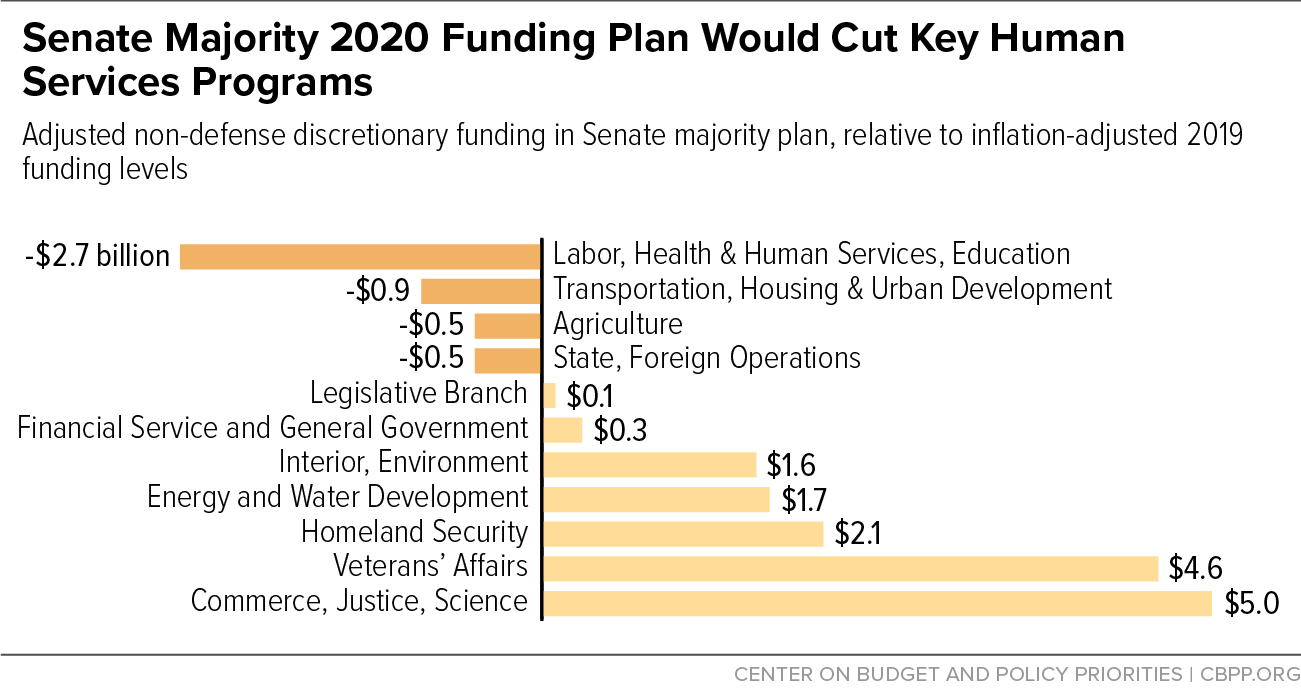Note: This paper focuses on the Senate Appropriations Committee allocations to its 12 subcommittees. For details on selected subcommittee bills and individual programs, see:
Congress and the President negotiated an agreement in July to avoid the very steep cuts to fiscal 2020 appropriations bills that the 2011 Budget Control Act (BCA) would have required and to provide additional resources for modest investments in non-defense as well as defense programs. But relative to 2019 funding as adjusted for inflation, the Senate majority plans to cut funding for the two appropriations bills that cover key public health, education, rental assistance, and other human service programs, devoting all the available funding increases and more to other areas.
The BCA established caps on defense and non-defense discretionary (NDD) funding through 2021, and the new appropriations agreement reset the caps for 2020 and 2021. For 2020, the agreement set the cap for NDD funding at $621.5 billion, or $24.5 billion more than the 2019 cap level (a 4.1 percent increase). But these calculations do not take into account the effects of inflation, nor do they include funding that is allowed outside the caps.[1] When these adjustments are made, the NDD funds available in 2020 are $10.8 billion higher than the inflation-adjusted 2019 level, or a 1.7 percent increase.
The plan introduced by Senate Appropriations Chairman Richard Shelby to allocate this NDD funding among the Committee’s 12 subcommittees includes obvious winners and losers, with funding for the losers being cut below their inflation-adjusted 2019 levels (see Table 1 and Figure 1):
- The appropriations bill funding the departments of Health and Human Services, Education, and Labor would be cut 1.4 percent below its inflation-adjusted 2019 level, a cut of $2.7 billion. This bill funds key programs such as: Title I education for the disadvantaged, education for students with disabilities (known as IDEA), Pell grants, child care, Head Start, community health centers, the National Institutes of Health, the low-income home energy assistance program, and Social Security administrative costs.
- Funding for the Department of Housing and Urban Development (HUD) and the Department of Transportation would be cut by 1.1 percent, or about $900 million, below the inflation-adjusted 2019 level. The bill’s two biggest programs help 3.4 million seniors, families with children, and other low-income households pay rent and make ends meet. Because rents are expected to grow faster than the consumer price index overall, inflation-adjusted funding must rise, not fall, to prevent cuts in the number of households receiving rental assistance in 2020. But to provide the necessary increase for housing assistance, the Senate would need to cut transportation programs or other HUD programs by a noticeable amount.
- The Agriculture subcommittee would similarly see its inflation-adjusted funding cut by 2.1 percent, or about $500 million, and the State Department and Foreign Operations subcommittee would be cut by 1.0 percent or about $500 million in inflation-adjusted terms.
In contrast to these funding cuts, some appropriations bills are slated for noticeable increases even after accounting for inflation. In two cases, the Appropriations Committees have little choice but to provide increases:
- The bill funding veterans’ health must account for the new MISSION Act, which increases access to health services provided outside VA facilities. The Senate allocation to that subcommittee, an increase of 5.1 percent or $4.6 billion over the inflation-adjusted 2019 level, appears intended to cover the needed increase.
- The Commerce Department needs a significant increase to fund the 2020 decennial census. The Senate allocation to that subcommittee is an increase of 8.2 percent or $5.7 billion, and a substantial portion of that increase appears intended to address the necessary census costs.
The Senate majority would provide other subcommittees with notable increases, reflecting policy preferences rather than costs associated with previously enacted legislation or the constitutionally mandated decennial census. In essence, programs in these areas would receive their increases at the expense of human services.
- Homeland Security would receive an inflation-adjusted funding increase of 4.3 percent or $2.1 billion.
- Funding for energy research and for water development programs — dams, barge canals, harbor dredging, and so on — would increase by 7.6 percent or $1.7 billion.
| TABLE 1 |
|---|
| From largest gross percent cuts to largest gross percent increases; dollars in billions |
|---|
| Subcommittee |
Percent |
Dollar |
|---|
| Agriculture |
-2.1 |
-0.5 |
| Labor, Health & Human Services, Education |
-1.4 |
-2.7 |
| Transportation, Housing & Urban Development |
-1.1 |
-0.9 |
| State, Foreign Operations |
-1.0 |
-0.5 |
| Financial Service and General Government |
+1.1 |
+0.3 |
| Legislative Branch |
+2.8 |
+0.1 |
| Interior, Environment |
+4.5 |
+1.6 |
| Homeland Security |
+4.3 |
+2.1 |
| Veterans Affairs |
+5.1 |
+4.6 |
| Energy and Water Development |
+7.6 |
+1.7 |
| Commerce, Justice, Science |
+7.3 |
+5.0 |
| NDD appropriations overall (average percent, total dollars) |
+1.7 |
+10.8 |

